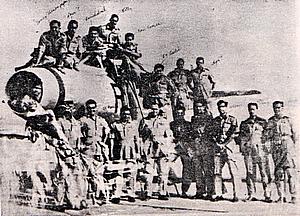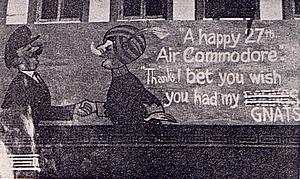| Photo Albums : I. 70th Pilots Course | II : No.20 Squadron (1957) | III : 101 Sqn, 2 Sqn and Others |
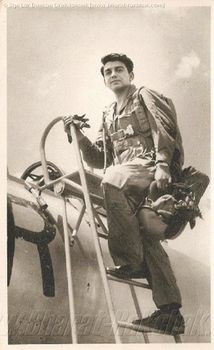 Introduction
Introduction
Yes, I still look back on my years in the Indian Air Force as some of the best years of my life to date. When and where did it all start. I think it goes back to when I was a young bloke living in Chittagong in 1944-45. I can remember the Spitfires flying over our home heading off to front the Japs. The Spits would go out in formation and an hour or so later they would return in dribs and drabs. My father would get me to count the aircraft going out, and then we would try to count them returning to see how many were missing. Then one day Dad returned home from tour (he was in the Railways and would tour sections of the railway line on his Motor Trolley) and said he had come across a Spitfire that had Bellylanded beside the railway track. So the next time Dad went to that area I went along. He would drop me off where the Spitfire was and then pick me up on his way back.
The aircraft was intact except that it was resting on its belly. I would sit in the cockpit and play with the controls and imagine I was flying out to combat like I had seen the ones flying over my home. Dad would pick me up on his way back and he, in later years, told me I couldn’t stop talking about what I would do when I joined the Air Force and how I would fly the Spitfire. I never got to fly the Spitfire but I did join the INDIAN AIR FORCE.
Immediately on completing my education I applied for the Air Force. I remember going to Dehra Dun to the Services Selection Board and fronting Wg Cdr Bobb at the interview. The first question he asked me was why I wanted to join the Air Force. Without a second thought I replied “Because I wanted to fly Fighter Aircraft and also because the Air Force paid well”. Wg Cdr Bobb sat back in his chair and laughed, I was left wondering what I had done wrong. Then he sat up and said that that was the most honest answer he had had. The most frequent reply was that they wished to join the services to fight for the “MOTHERLAND”.
With that I considered I had struck the correct note for shortly after I was called up to join the 70th Pilots Course at No.1 Air Force Academy at Begumpet. I was beside myself and eager to get to Begumpet having no idea what awaited the Junior Flight Cadet, the lowest form of humanity in the Service.
70th Pilots Course
It was October 1955 and 33 trainees (made up of ex-airmen and direct entry cadets) arrived at Begumpet to be greeted by the very enthusiastic group of Senior Cadets, (Keith Lewis, Pete Gaynor, Pope Pious, Jasjit Singh, to mention a few),who proceeded to make our lives hell for the next few months. Yes, hell to the extent that it made me wonder whether it was worthwhile going through all this just to fulfil a childhood dream to fly. The answer of course was “Yes”.
Our pilots course was the first full course to do the Basic Flying Training on the HT2, Hindustan Trainer Mk2. After two months of intensive ground training (and ragging) we finally commenced flying in December 1955. My first sortie was on 6th December 1955, air experience with Flt. Lt. Rajan. I thought all my Christmas’ had come at once, It was the most fantastic feeling being up there, it was what I had imagined it to be. After the sortie I was walking back to the crew room and I looked at the two doorways. One had over it a sign that read “Through this door walk the best Pilots in the world”. If I had dared go even near that door I would have been in deep S—t, so I sneaked in through the other door.
The next month would have to have been the most harrowing time I have ever spent. Every few days someone would be listed to fly with the CFI and the next you knew the poor cadet was packing his bags to leave. Was it your turn next? Furthermore the HT2 had a bad habit of getting stuck in a spin. Unfortunately Flt. Lt. Derrick Watts and his pupil Flt. Cdt. Sharma were unlucky not to make it back from a sortie involving spins. What with all this my morale was way down in my boots.
Then came the 6th January 1956 and I checked the Flying Programme for the 7th January 1956 and I am to fly with the CFI, Sqn Ldr Millicans for a “solo check”. My instructor Rajan assured me that there would not be a problem, but do you think I could sleep that night wondering what was in store for me. As it turned out all went well, I went solo and that would have to be the most exciting experience of my life. I came back and entered the crew room via the door for the best pilots in the world.
Now life became more bearable. Even though you were still a Junior Flt. Cdt., the lowest rank, you took it all in your stride and waited for the day when you could give the Senior cadets their share of what they put you through.
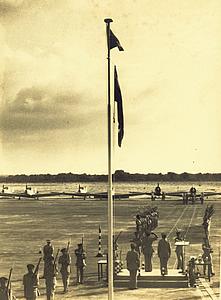
|
Cadets of 69th Pilots Course receive a guard of honor from their juniors – Cadets of the 70th Pilots Course. |
My basic training did go through without a hitch and we were now looking forward to flying the Harvard T6G for the advanced part of our training. On the 31st March 1956 we had our chance to get even with our seniors, just a few special ones. I remember getting hold of the Academy Under Officer, he’ll know who it was, and throwing him into the swimming pool. The laugh was on me. He could not swim so I had to dive in and rescue the bugger. I can still see that lean, long, figure running back to his room, naked.
So we entered a more serious and exacting period of our training, The Advanced Stage. I had a new instructor, Fg Offr Raghavan. Even though I got on well with Flt Lt Rajan, with Raghavan I was more at ease and my flying skills seemed to improve markedly. Raghavan detected my ability to do a Slow Roll and he did all he could to get me to perfect it. Come my final test with Sqn Ldr Millicans, I remember him asking me to do a Slow Roll. During the manoeouvre I could hear Millicans falling round in the back cockpit and when I came out of the roll he said “I said slow roll, but not that bloody slow”. It must have been that that won me the Patiala Trophy for the best in flying.
Commissioning
And come the 30th November 1956 the 70th Pilots Course passed out and we were presented our wings and trophies by then Air Cdr. Lal, Air Officer Commanding Training Command. The course that commenced 33 strong, passed out only 17 which included one from 69th course and one from 68th course. So I do think we really earned our wings and I for one thought I was on track with my ambition as I was selected to fly Vampires and be a Fighter Pilot.
Just our bad luck, Hakimpet runway was undergoing repairs and JTW (Jet Training Wing) was moved to Warangal where there was a old World War 2 runway. So the 69th and 70th Courses did our Vampire conversion there. Very primitive, all tented accommodation and we survived one very bad hailstorm that left only the Mess and Kitchen standing. Even some aircraft were damaged by the hail. We also missed the great social life of Secunderabad, but we made the most of what was available, yes what was available!!!!!
The leap from the T6G to the Vampire Mk52 was awesome. From the very first sortie on 2nd January 1957 with Flt. Lt. Woodfall I knew I was going to enjoy my flying career. I went solo on 11th January1957, not realising what an important part the Vampire, both Mk52 and the T55, would play in my flying career. Aerobatics, the “G” effect, Formation Flying, Low Flying, the feeling of speed all came together to make you feel ten foot tall. Another little bonus came my way when I was awarded the Presidents Plaque for the All Round Best Officer from No1 Air Force Academy for the Year 1956.
I completed the Jet Conversion in April 1957 and was posted to No. 20 Squadron effective 4th May 1957.
No 20 Squadron, 4th May 1957 – 28th September 1957.
This squadron at the time was an Operational Training Unit, with Vampire aircraft based at Halwara. Commanded by Sqn Ldr K.M.Ram and a great bunch of blokes, Berty Weir, Stumpy Watts, Sanadi and Raghavandhran, just to mention a few. It was a hectic few months taking us through all the high and low level exercises, tactical formations, ranging and tracking and a few dogfights thrown in for good measure. That was the flying aspect that I was revelling in.
| Squadron Leader K M Ram was the first Commanding Officer of No.20 Squadron. | 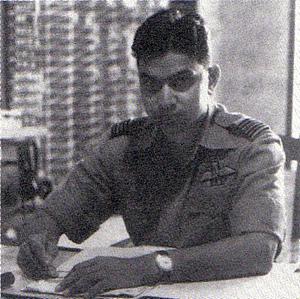
|
The other part of the training was being initiated into roughing it out camp style and learning how to hold your liquor, I learnt that the hard way. The squadron ran a fine system where for doing something you were not supposed to do, a fine of a bottle or two of beer was imposed. When there was enough beer in the kitty we would have a beer party. It was one of those very hot days in June and I was going to test my capacity for beer. I suppose I must have contributed a fair wack to the kitty so I was going to have my share and more. By about 5pm I was rotten. It took some four guys, Tully, Ferdy and a few others to get me back to my tent. Then I must have passed out because I can’t remember a thing till I surfaced round 4am.
Surprise, besides the throbbing head I could not move my tongue. I woke my tent mate Tully, who laughed his head off and then told me what had transpired. Sometime after they had got me back to the tent Tully returned to see how I was. He found me frothing from the mouth so called the Squadron Doc who reckoned it was just the overflow of beer. To be on the safe side the doc decided to tie my tongue to the lobe of my ear so that I might not swallow my tongue in my drunken stupor. What an experience, it’s a wonder that I ever had another drink in my life. But I can assure you that I did.
Come September and we were certified Ops/Ut and posted to various fighter squadrons. I was posted to No. 101 FR SQN.
No. 101 FR. SQN. 29th September 1957– 22 December 1958.
At this time the squadron was based at Palam and commanded by Sqn Ldr Jock Lloyd and Flt.Cdr. was Flt.Lt. P.S.George. The squadron was originally 101 PR and had Spitfires (the closest I ever got to the Spit). When changing to the FR (Fighter Recce) role the Squadron was equipped with the Vampire T55 that had three F95 cameras in the nose of the aircraft. I was looking forward to a new and exciting phase in my flying. Fighter Recce was new concept and it was up to us to evolve and put together all the procedures and tactics, not to mention all the authorised low flying.
Much to our relief in November 1957 the squadron moved to Adampur, away from the hassles and flying restrictions of Palam. Then we were joined by the likes of Handa, Kothawalla, Soorma, Shelby and a host of other great blokes. It was the late Ludwig Shelby that put together the 101 FR Sqn. Crest, a falcon on a gloved fist. The idea came from a Shell advertisement in one of the Flight Magazines.
As expected the flying was very exacting and being an entirely new concept was very exciting, the low flying in particular. On one occasion I was allocated the task of photographing an Army AOP Auster aircraft that was flying very low over the Beas river. I finally got this little aircraft, flying bearly 50feet off the deck, into my sights to take a few shots. I called to co-pilot Gadre to set the camera to “Port 4”. No response, there was I turning at round 6 G trying to keep the Auster in my sights. So I look to my right and there is Gadre, head nodding, out for the count. He had “blackedout”. Unfortunately poor Gads was in a bad way and we just made it back to base in time.
While on the topic of the AOP, I was once approached by Capt. Sihoto to take him up in a Vampire. One day an air test came up and Sihoto was available so I took him up with me. After I had done what I needed to do as far as the air test was concerned, I asked him if there was anything he would like to see or do. He wanted to feel the effects of “G” which he personally thought were very overrated. So I proceeded to do a loop pulling round 4”G” but he was not impressed. So I did a “roll-off-the-top” pulling about 5.5”G”. He still thought that the effects of “G” was no big deal. That was it. I was going to show Capt. Sihoto what it was all about. I did not tell him that I was going to do a “triple-roll-off-the-top”. I put the aircraft into a dirty dive building up max speed and pulled out at 300ft. It was almost 9”G” and I checked Sihoto who had blackedout before I completed the first roll-off. I continued with the second and the third before he surfaced. His first words, very slurred, were “yes now I know what its like”.
But the drama did not end there. The next thing I knew the aircraft was vibrating, the engine RPM was surging and the JPT was way off. I throttled back but then could not open throttle again without violent vibrations. We were near the airfield so I decided to force land on the runway. Capt. Sihoto was getting more than he bargained for, I think. I remember calling up ATC to advise that I was coming in for a “deadstick landing” and Fg. Offr. Sandhu come in “welcome, dear. I will keep the runway free for you”. From then all went well, Sihoto holding his calm and a successful “deadstick landing”. The aircraft was one of the old IY series (IY526) and the excessive “G” caused a rear bearing failure and also popped a few rivets on the wings.
Life in the squadron wasn’t all work, there was some play as well. Like the occasion when the we, with Jock Lloyd in the lead, trooped into a big army mess in Jalandhar for some function. Very early in the evening I noticed a cricked bat in a glass case hanging in the reception area. As the evening wore on we decided that the cricket bat would surely look better in our crew room. So that was where it ended up. The trophy turned out to be a bat signed by all the players of one of the very early English cricket sides visiting India. A prized piece no doubt. So within a few days the Army General was on the blower to our Station Commander declaring that they knew who had removed the trophy and would appreciate it if it were returned. Jock Lloyd as PMC called a meeting of all the officers advising them of what had transpired and requesting that who ever had the trophy should deposit it in the Mess foyer that night. He would then collect the item and return it to the Army and so the officers responsible would not be identified. All went to plan, but before returning the bat, we removed it from the case and signed our names on the back of the bat. I wonder where that trophy is today.
It was now December 1958 and I was “Certified Fully Opps Fighter Recce”, got my first Motor Bike (a BSA 3.5). Of course the leather jacket and the Ray Bands and with that came my posting to Toofanis. What more could a bloke ask for.
No. 2 Sqn. 23rd December 1958 to 14th June 1961.
No. 2 Squadron with Toofanis was based at Halwara. Sqn Ldr T. Zachariah was the Sqn. Cdr. and Dennis LaFontaine was one of the Flt. Cdrs. On 14th Jan 1959 Dennis took me up in a Vampire T55 for a solo check and sent me solo on the Toofani. There was a bit of excitement because not long after I got airborne, Halwara was hit by a bad sand storm and I had to divert to Ambala. First solo and a mini cross country all in one.
From here on the flying was intense and exhilarating. The high and low level tactical exercises, live armament exercises and all the fighter flying you could ask for. S.D.Mohan and I had some great dogfights starting off at 20,000ft. and calling it off at 1000ft. “I think we ended up quits, didn’t we Mohanjee?”.
One of the most memorable flying incidents with 2 Sqn. was the big Air Display held at Bombay on 1st April 1960. I think every squadron at the time took part. There were fighters, bombers, transports and even helicopters. There was Formation Aerobatics, Live Armament demos in the bay and a few other fun things. Air India had just taken delivery of the Beoing 707 which did a fly past with two Gnats in formation on it on each wing. As they passed the Saluting Dais the Gnats would peel off and zoom away leaving the Boeing look as though it was suspended in mid air. Then Wg.Cdr. Das would come back in the Gnat and do his celebrated point roll barely a few feet over the sea. Breath taking.
I was flying in the Toofani formation aerobatic team lead by Sqn Ldr S.B.Sheorey, No.2 “Charcha” Malik, No.3 S.D.Mohan and yours truly at No.4. We would complete our manoeuvres trailing the tri-colours. During practice the Hunters were pulling out well below the authorised pull out height and were getting away with it, mainly because of the likes of Bharat Singh who was leading the Hunters. Sheorey did mention on one occasion that if they could get away with it, why not us. After what we had just heard Mohan and Malik both advised me to be careful. If at anytime I felt unsafe, they said, I should peel off.
The next day at practice we went into the dive for the first loop. After all the practice we had put in, I felt we should be pulling up but we seemed to keep going. Then I saw Sheorey pulling out and it seemed tighter than normal. From the corner of my eye I saw both Mohan and Malik peel off but I did not take their advice and tried to keep up with the leader. I suddenly flipped on to my back. I had never been that close to the sea and upside down. I don’t know how I recovered, pure instinct I put it down to. As I was pulling away I am sure I could see the foam on the waves. Needless to say we did not get back into formation, but went back and landed individually at Santa Cruz . Fortunately Sheorey learned his lesson and from then on all went well and the Toofanis, because of the tri-colour, were a hit with the Bombay public.
As I mentioned earlier Air India had not long taken delivery of the Boeing 707. To coincide with our Air Display Air India put up a huge advertisement, about 10ft by 8ft, at the famous Kemps Corner in Bombay. It featured the Boeing 707 and the Air India Maharajah speaking to an Air Cmdr. saying “A happy 27th, Air Commodore, Bet you wish you had my Boeings”. This was just too much to take without some sort of counter attack. Sheorey, who was a very good artist was going to make a few alterations to the poster. We surveyed the area and located a mobile ladder which they used for the tram car overhead cable maintenance and Sheorey organised the paint and brushes.
A few days later, Dev Anand, the actor, invited all the Air Force Officers to his Juhu home for a big party. A grand time was had by all and on our way back the 2 Sqn. blokes decided to return via Kemps Corner. There we were at 2am. getting the huge ladder in place for Sheorey to make the necessary alterations to the poster. He painted in some Gnats, shaved off the Maharajah’s whiskers and now had the Air Commodore addressing the Maharajah. “Thanks! I bet you wish you had my Gnats”. It was a perfect job and Air India took it in the right spirit, actually leaving the poster like that for months. Air India even sent 2 Sqn. a photograph of the revised addition.
Back to Halwara and extensive operational flying and live armament practice at Ambala and Palam. I was certified Fully Operational and with it came my posting to FIS (Flying Instructors’ School).
Flying Instructors School – 1st July 1961 to 10th December 1961.
It was time I got some qualifications so what better than to qualify as a Flying Instructor. So here I am at Tambaram along with twenty five other pilots, which included one Army Officer and one Afghan Air Force pilot, (I wonder where he is today). The CO was Sqn Ldr Upot and Flt. Cdr. was Flt. Lt. Tilak. After twenty one days of ground subjects, I don’t know how I managed to keep awake in class, we finally started flying. I had Tilik as my instructor and it was interesting flying the HT2 and the T6G again. It was one thing flying the aircraft. but to go through all the manoeuvres and coordinate the patter was something else. Eventually it all fell into place and I was fortunate enough to pass out winning the Flying Trophy. It was called the Chief’s Trophy, Presented By Air Marshal S . Mukerjee, in March 1959.
Air Force Flying College, Jodhpur – 11th December 1961 – 15th July 1963.
Now this was a challenge if ever there was. I could fly and I loved it, but was I going to be able to teach another individual to fly. I was soon put to the test with my first cadets, Singla, Koshal, Bobb and Brown. It turned out that Peter Brown was too tall for the HT2 and ended up doing his Basic and Advance Training on the T6G. Yes, I did send the other three solo and I can assure you that it was as great a thrill sending them solo as it was when I did my first solo. I saw them through the basic stage and we then moved on to the Advance stage flying the T6G. The three of them were good pupils and from what I hear went on to make a name for themselves flying Heilecoprers. In July 1963 I got posted to No2 Jet Training Wing, Bidar.
No.2 JTW, Bidar, 16th July 1963 to 8th November 1964.
The CFI was Sqn Ldr Eric Allen and Flt. Cdr was A.B.Lamba. After all the flying I had done on the Vampire T55 when I was in 101 FR Sqn, now to be instructing on this aircraft was a pleasure. The pupils were taken through all the General Flying ie. Aerobatics, Close Formation, Navigation etc. and then posted to the various Opps. Trg. Squadrons. Everything went well with me till it came time for me to leave Bidar.
For some reason the Station Commander and I never hit it off. It all came to a head at my farewell party when he walked out of the Mess as my presentation was in progress. By the end of the night I had had a skin full. On my way back from the Mess to my room I decided to rearrange the Stn. Cdr.’s office. Not being satisfied with that, I then proceeded to hoist my underpants up the flag mast. After much fun and games, Eric finally got me back to my room.
I surfaced round 3am and realising what I had done, decided to make a quick get-away before the Station came to life. Eric Allen and all the other guys saved my skin. When asked none of them knew what had transpired. Thanks, guys. I proceeded to Poona on my next posting.
No. 45 Sqn. Poona, 9th November 1964 to 31st March 1966.
The squadron was commanded by Sqn Ldr S.K. Dahar and Flt. Lt. M. Banerji was the Flt. Cdr. We were flying Vampires and the role of the squadron was putting newly commissioned pilots through basic operational training. But come June 1965 we were put on a more opps footing and moved up to Ambala. We did extensive opps training both day and night in the hottest time of the year. I remember one stifling afternoon I was asked to air test a Vampire that was having problems with the undercarriage warning lights. I took the aircraft up, but no, the problem was still there. The undercarriage red lights would remain on in flight. I told the maintenance staff what I thought was the problem, but “we pilots don’t have a clue what we are talking about”.
Over the next three or four days every afternoon this beastly aircraft kept coming up for the air test. On the fourth attempt the problem reappeared and that was when I made up my mind that this aircraft was not going to fly again. I put the undercarriage down and commenced to do some aerobatics. In no time at all I noticed pneumatic failure. The pneumatic hoses in the wheel bay had ruptured. As I had no brakes I contacted flying control and requested the barrier be put up at the end of the runway. I landed and engaged the barrier and that Vampire never flew again.
By July 1965 the India Pakistan tension appeared to have eased and 45 Sqn. moved back to Poona. But the recess was short lived. On 30th August we were moved north again, this time to Pathankot. Expecting the same situation as earlier in the year, I was quite happy to return to Poona to ferry back our trainer. But within two days the squadron was called into action. The disaster of those first sorties was a horror for the Vampires. I lost one of my best mates that day, and to think that Bhagwagar was leading the formation that I was to have taken into action.
I returned north as soon as possible, but by this time the squadron had been moved back to Hindon. S. K. Dahar and I had some heated discussions regarding the events of that first day. I could never understand why he and his formation hung around in the area after they completed their mission. I did a number of sorties on the T55 doing radar calibration round J&K area. I could not get back to Hindon and would stop over at Pathankot and be kept awake all night by the Pakistan bombers. The odd bottle of whisky helped through the night but was no help for a dawn take off. The remedy was to suck 100% oxygen when you first got into the cockpit. That did work wonders!
Dahar’s formation had made two trips into Pakistan via Sirsa trying to locate a large fuel dump with no success. When the Opps. Room asked for another sortie for this target, Dahar was quite willing to let me go as he was convinced that there was nothing there. My formation comprised of myself in the lead, Gordon Carver No.2, M.P.Yadav No.3 and I can’t remember the fourth pilot. “Dadhu, if you can remember let me know”.
We took off from Palam, refuelled at Sirsa and headed into Pakistan. We went in really low and the plan was that when we arrived at a certain railway line, Gordon and I would turn left and Yadav and his wingman would go right. After turning we flew for about 10 minutes and we were in luck. A few miles to my right I located the fuel dump. I drew Gordon’s attention to the target and pulled up to go into attack. We encountered some rifle fire. Nothing to talk about. I went into the attack, uncaged the sights with the front guns and that started the fire works. Then I gave it all sixteen rockets and pulled away leaving the biggest bomb blast I had ever seen.
As I was pulling away I saw Gordon going in for his run. I watched him enter the dive and then lost him. I eventually saw him pulling out through all the blasts. He had gone too low and was lucky to have come through. Unfortunately he had sustained some grazing of the windscreen and canopy resulting in impaired vision. I got him into close formation and flying as low as we could, I headed for home. We were warned that there could be Sabres in the area but fortunately crossed the border without incident.
The next task was to bring Gordon in for a landing. He could hardly see out of the canopy, so I brought him in to land in formation right down to round off. Then I over shot and Gordon went in and landed. For me and my formation a very successful sortie, but Dahar was not impressed and it was a mystery how my camera films went missing.
What I can confidently claim is that on the 20th September 1965 I led the last successful Operation Sortie on the Vampire Mk 52. Seven days later we headed back to Poona to mull over all that had happened in the last month. Needless to say I didn’t stay long with S.K.Dahar. Thanks to Groupie Ronnie Engineer I was posted to No. 221 Sqn.
No 221 Squadron, Poona, 1st April 1966 to 7th August 1966.
The Squadron Commander was Ian Rebello and Pete Gaynor and I were the Flight Commanders. We flew Vampires and the squadron role was still training. Groupie Engineer flew with us regularly and most times I would fly with him. One incident I had was an engine failure and dead stick landing on the runway. At least I scored a “Good Show” remark by Ian Rebello in my log book for that incident.
Jet Bomber Conversion Unit, Agra – 8th August 1966 to 15th November 1966.
The squadron Commander was P. Gautam and Flight Commander Dushyant Singh. Converting to the Canberra was something very different for me. Twin engines and a navigator was a luxury I had never expected in flying. The size of the aircraft compared to the little Vampire was daunting. But as it turned out I had no problems and my conversion went through without a hitch. At the end of the course I was posted to No. 35 Sqn. in Poona.
No. 35 Sqn. Poona- 16th November 1966 to 9th April 1969.
The Sqn. Cdr. was Wg. Cdr J.S.Wohra and Flt. Cdr. was Sqn Ldr Talwar. For me the Canberra B58 was another big fighter plane and in a very short time I was flying it like a fighter. I did all the aerobatics on the Canberra that could be done on a Vampire. If I were going for an air test there would be a queue of navigators wanting to fly with me, they were all very discreet, I must say.
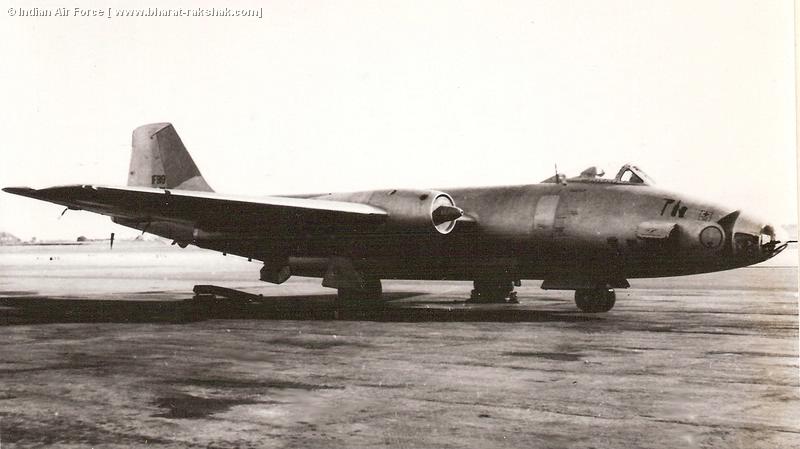
|
| A Canberra B(I)58 of No.35 Squadron, based at Poona. |
I was fortunate to have Pete Wilson in Poona at the time. He once briefed me on how to do a short landing on the Canberra and the day I tried it, didn’t the air traffic control panic. They reckoned they had never seen a Canberra turn off the runway so soon. On another occasion I was practicing ILS landings at Santa Cruz airport. My navigator, Flt. Lt. Kak remarked that he heard I came from Bombay and wondered where I lived. So I decided to show him. After I did the last roller take off, I kept very low and went out to sea. Then I turned back and headed to my home that was on Carter Road, near the sea. We were very low, doing about 550Kts. From a bus at the bus stop the passengers all scattered and we pulled over the House and Pali Hill at the back and climbed away. Kak was silent through all this. We got to about 2000ft and then he says “I wanted to see the house, Sir, not the colour of the bloody curtains”. So, yes, twin engine flying was great and being in Poona I still kept my hand in on the Vampire. Groupie Engineer would ring 221Sqn. and ask for two Vampires to be kept ready for him. Then he would contact me at 35 Sqn. and tell me what time we were Flying and would send his Jeep to pick me up. Didn’t that stir people up.
Like all good things this wonderful lifestyle was about to come to an end. For personal reasons I had resigned. I had had almost fifteen years of doing what I loved doing best. I had made a host of friends that till today I still count them as my BEST MATES. It was because of some of them that I lasted as long as I did. I should have been Court Martialled on a few occasions, but was saved by some of these guys. Speaking of friends I have come across them in the most unexpected places. In 1979 I was in Bagdad, Iraq on business. In the evening I was walking down the street going for a meal and I hear “Shanks, Sir. Shanks, Sir” It was three of my pupils from the Air Force. They were in Iraq training the Iraqi pilots. What a small world.
So on 9th April 1969, as a Squadron Leader, I terminated my commission.
The Author, Sqn Ldr Duncan Cruickshank (retd) lives in Brisbane, Australia.
Copyright © Squadron Leader Duncan Cruickshank . All rights reserved. Reproduction in whole or in part in any form or medium without express written permission of Squadron Leader Duncan Cruickshank is prohibited.
